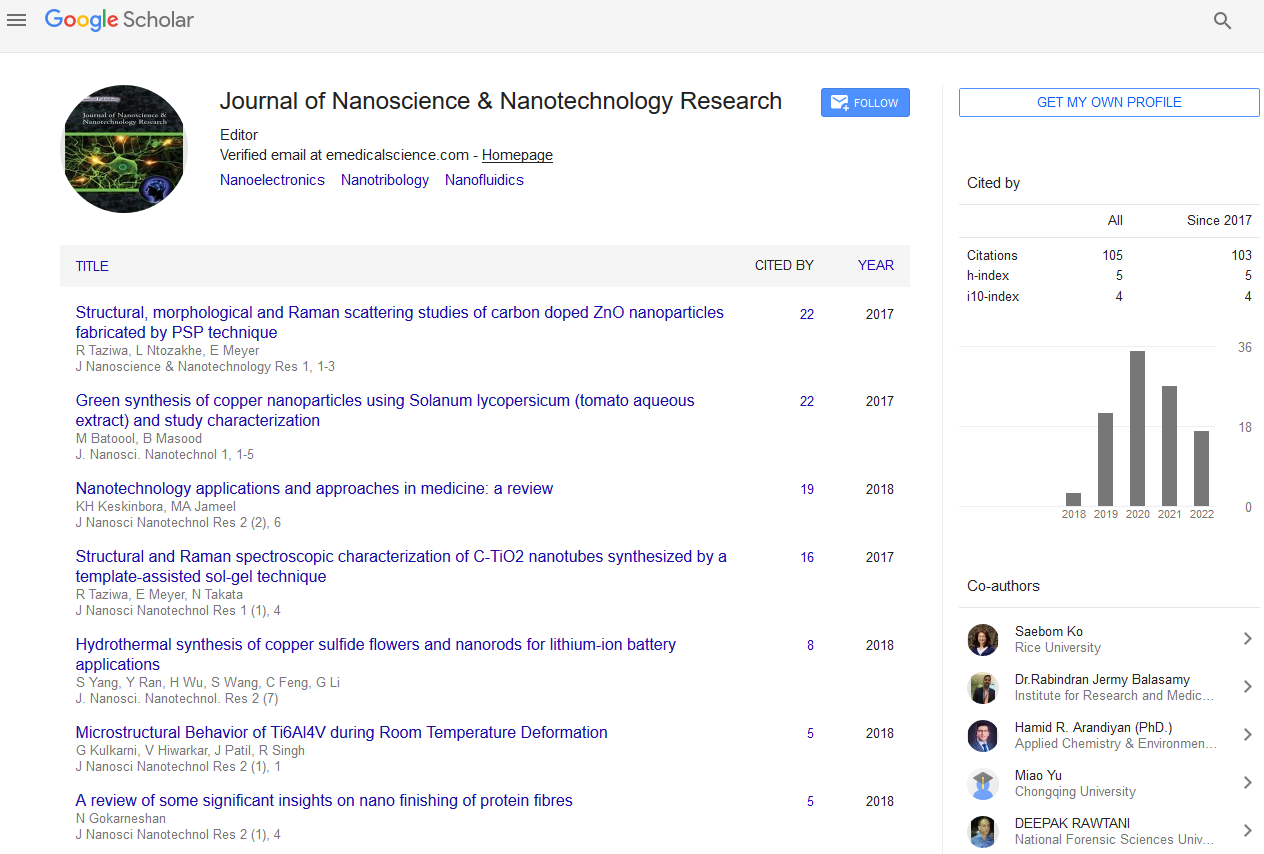Short Communication - (2024) Volume 8, Issue 3
Advances in Nanocomposites: A Breakthrough in Material Science
Vicky Ogbonna*
Department of Public Health, University of California, United States
*Correspondence:
Vicky Ogbonna,
Department of Public Health, University of California,
United States,
Email:
Received: 02-Sep-2024, Manuscript No. ipnnr-24-21754;
Editor assigned: 04-Sep-2024, Pre QC No. ipnnr-24-21754 (PQ);
Reviewed: 18-Sep-2024, QC No. ipnnr-24-21754;
Revised: 23-Sep-2024, Manuscript No. ipnnr-24-21754 (R);
Published:
30-Sep-2024, DOI: 10.12769/IPNNR.24.8.21
Introduction
Nanocomposites represent a transformative innovation in
material science, combining nanoscale materials with bulk
materials to create hybrid substances with enhanced properties.
This synergy between nanotechnology and traditional
composites has led to the development of materials with
superior mechanical, electrical, and thermal characteristics.
Such advancements hold promise across various industries,
from aerospace to biomedicine, where lightweight, highperformance
materials are in high demand. Nanocomposites
are materials made by integrating nanoparticles typically
ranging from 1 nm to 100 nm in size-into a matrix composed of
polymers, metals, or ceramics. Unlike conventional composites,
which rely on micron-sized reinforcements, nanocomposites
capitalize on the unique behaviors of materials at the nanoscale.
These behaviors often include improved strength, conductivity,
and resistance to environmental degradation.
Description
The most common types of nanomaterials used in
nanocomposites include carbon nanotubes (CNTs), graphene,
nanoclays, and metal nanoparticles. Each of these materials
brings specific advantages. For instance, carbon nanotubes
are renowned for their exceptional mechanical strength and
electrical conductivity, while graphene is known for its thermal
conductivity and flexibility. When embedded into a matrix,
these nanoparticles modify the physical properties of the
host material, often leading to remarkable improvements in
performance. Nanoparticles such as CNTs and graphene have
incredibly high tensile strengths. By incorporating these into
polymer matrices, nanocomposites demonstrate significantly
improved mechanical strength and stiffness. This enhancement
makes them ideal for applications where weight reduction
and material toughness are critical, such as in aerospace and
automotive industries. Adding conductive nanomaterials,
like CNTs or graphene, to non-conductive matrices results
in nanocomposites with excellent electrical properties.
These materials are particularly useful in the electronics
industry, where they can be used in sensors, transistors,
and flexible electronic devices. For example, graphenebased
nanocomposites are being explored for their potential
use in high-performance batteries and supercapacitors.
Nanocomposites are also prized for their improved thermal
properties. Nanomaterials like graphene and nanoclays can
increase a material’s thermal stability and conductivity. These
properties are crucial in industries like electronics and energy
storage, where heat management is essential to maintaining
device performance and longevity. Nanocomposites can
also offer superior barrier properties, making them useful in
packaging and protective coatings [1-5].
Conclusion
Environmental and Energy Applications: Nanocomposites are
also being developed for environmental applications, such
as in water purification and air filtration systems. In energy,
nanocomposites are being researched for use in fuel cells, solar
panels, and batteries, where their enhanced electrical and
thermal properties could lead to more efficient energy storage
and conversion. Despite their potential, there are challenges
in the development and commercialization of nanocomposites.
One of the primary challenges is the uniform dispersion of
nanoparticles within the matrix, as agglomeration can lead to
a reduction in the material’s overall performance. Additionally,
the high cost of nanoparticle production and integration can
be a barrier to widespread adoption. Research is ongoing to
overcome these challenges by developing more cost-effective
production methods and ensuring consistent nanoparticle
distribution. In conclusion, nanocomposites are poised to
revolutionize material science, offering unprecedented
improvements in strength, conductivity, and thermal stability.
As researchers continue to overcome technical challenges, the
potential applications of nanocomposites will only expand, further driving innovation across multiple industries. Their
versatility and superior properties ensure that nanocomposites
will play a critical role in the future of technology and
engineering.
Acknowledgement
None.
Conflict Of Interest
None.
References
- Daelemans L, De Baere I, Rahier H (2016) Damage resistant composites using electrospun nanofibers: A multiscale analysis of the toughening mechanisms. ACS Appl Mater Interfaces. 8(18):11806-18.
[Crossref] [Google Scholar]
- Rabiee N, Bagherzadeh M, Ghadiri AM, Fatahi Y (2021) Turning toxic nanomaterials into a safe and bioactive nanocarrier for co-delivery of DOX/pCRISPR. ACS Appl Bio Mater. 4(6):5336-5351.
[Crossref] [Google Scholar]
- Advincula RC, Dizon JRC, Caldona EB (2021) On the progress of 3D-printed hydrogels for tissue engineering. MRS Commun. 11(5):539-553.
[Crossref] [Google Scholar]
- Zhang J, Liu Y, Cui L (2020) "Lattice strain matching"-enabled nanocomposite design to harness the exceptional mechanical properties of nanomaterials in bulk forms. Adv Mater. 32(18):e1904387.
[Crossref] [Google Scholar]
- Zungu B, Kamdem PH, Gaorongwe JL (2023) Zn nutrients-loaded chitosan nanocomposites and their efficacy as nanopriming agents for maize (Zea mays) seeds. Front Chem. 11:1243884.
[Crossref] [Google Scholar]
Citation: Ogbonna V (2024) Advances in Nanocomposites: A Breakthrough in Material Science. J Nanosci Nanotechnol Res. 08:21.
Copyright: © 2024 Ogbonna V. This is an open-access article distributed under the terms of the Creative Commons Attribution License, which permits unrestricted use, distribution, and reproduction in any medium, provided the original author and source are credited.

